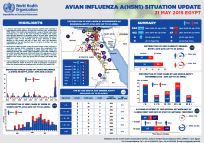Since September 2014 FluTrackers has compiled a list of Ministry of Health and WHO confirmed human H5N1 cases here and here. The total number of cases is 177 including 46 deaths. This is a case fatality rate of approximately 26%. While these lists are the best data the team at FluTrackers can collect from confirmed sources, this data is only an approximation of the actual situation. It is the minimum number of cases and deaths. The last officially reported onset date was April 6 for a human H5N1 case. No new cases have been publicly reported since then.
From September 22, 2014 through April 6, 2015 approximately 1 person per day was being confirmed as a human H5N1 case. In 2015 the rate has been also 1 per day. The reported cases seemed to have reached a peak in January and February. Reported cases declined to only 38 in March. April followed at 4 cases. In May there have been zero publicly reported cases. March to April to May is an incredible drop off.
If truly there were no reported human H5N1 cases in May, this would be perceived as "good" news. Why has this not been reported then?
No reports on the WHO Disease Outbreak News website. link
Latest WHO report on H5N1 in Egypt dated May 15 included reported data through April 30, 2015 link
Latest WHO report: Influenza at the Human-Animal Interface, monthly risk assessment summary dated May 1 included some April data. link
Latest public FAO Empress/GLEWS report dated February 26, 2015 link
Latest Eastern Mediterranean Regional Organization (WHO) report dated April 9 which included data through March 2015. link
Latest media report about human H5N1 suspected or confirmed cases picked up by FluTrackers was April 15: Egypt: Child Tested Positive H5N1 Bird Flu in Damietta
Apparently there is a total news and media block on this subject. So why - if the human H5N1 cases have declined to zero?
From September 22, 2014 through April 6, 2015 approximately 1 person per day was being confirmed as a human H5N1 case. In 2015 the rate has been also 1 per day. The reported cases seemed to have reached a peak in January and February. Reported cases declined to only 38 in March. April followed at 4 cases. In May there have been zero publicly reported cases. March to April to May is an incredible drop off.
If truly there were no reported human H5N1 cases in May, this would be perceived as "good" news. Why has this not been reported then?
No reports on the WHO Disease Outbreak News website. link
Latest WHO report on H5N1 in Egypt dated May 15 included reported data through April 30, 2015 link
Latest WHO report: Influenza at the Human-Animal Interface, monthly risk assessment summary dated May 1 included some April data. link
Latest public FAO Empress/GLEWS report dated February 26, 2015 link
Latest Eastern Mediterranean Regional Organization (WHO) report dated April 9 which included data through March 2015. link
Latest media report about human H5N1 suspected or confirmed cases picked up by FluTrackers was April 15: Egypt: Child Tested Positive H5N1 Bird Flu in Damietta
Apparently there is a total news and media block on this subject. So why - if the human H5N1 cases have declined to zero?



Comment